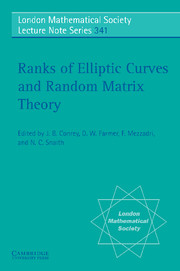Book contents
- Frontmatter
- Contents
- Introduction
- FAMILIES
- Elliptic curves, rank in families and random matrices
- Modeling families of L-functions
- Analytic number theory and ranks of elliptic curves
- The derivative of SO(2N +1) characteristic polynomials and rank 3 elliptic curves
- Function fields and random matrices
- Some applications of symmetric functions theory in random matrix theory
- RANKS OF QUADRATIC TWISTS
- NUMBER FIELDS AND HIGHER TWISTS
- SHIMURA CORRESPONDENCE, AND TWISTS
- GLOBAL STRUCTURE: SHA AND DESCENT
- Index
Some applications of symmetric functions theory in random matrix theory
Published online by Cambridge University Press: 10 November 2010
- Frontmatter
- Contents
- Introduction
- FAMILIES
- Elliptic curves, rank in families and random matrices
- Modeling families of L-functions
- Analytic number theory and ranks of elliptic curves
- The derivative of SO(2N +1) characteristic polynomials and rank 3 elliptic curves
- Function fields and random matrices
- Some applications of symmetric functions theory in random matrix theory
- RANKS OF QUADRATIC TWISTS
- NUMBER FIELDS AND HIGHER TWISTS
- SHIMURA CORRESPONDENCE, AND TWISTS
- GLOBAL STRUCTURE: SHA AND DESCENT
- Index
Summary
Dedicated to Persi Diaconis on the occasion of his 60th birthday
Introduction
This paper gives a brief and informal introduction to some applications of symmetric functions theory in random matrix theory. It is based on the lecture given as part of the program “Random matrix approaches in number theory” held at the Newton Institute from February to July of 2004; I would like to take this opportunity to thank the organizers for making this program such a wonderful and memorable one.
We begin, in section 2, by presenting a self-contained and fairly complete proof of the Weyl Integration Formula, the basic tool for averaging over U(n), following closely Weyl's original derivation. In the course of the proof we also provide a simple qualitative explanation for “quadratic repulsion” of the eigenvalues of unitary matrices. As a straightforward application of the Weyl Integration Formula we derive a simple but striking result of Rains on high powers of unitary matrices.
Following the organizers’ brief, in the exposition below I assume no prior knowledge of symmetric function theory. A crucial role in this theory is played by Schur functions and each section provides a glimpse of a different facet of their many-sided nature. In section 3 we introduce Schur functions and prove that they describe irreducible characters of the unitary group, following closely the derivation of Weyl in his classical book. In section 4 we prove asymptotic normality of traces of powers of random unitary matrices as a consequence of Schur-Weyl duality, following Diaconis and Shahshahani, who pioneered the symmetric functions theory approach.
- Type
- Chapter
- Information
- Ranks of Elliptic Curves and Random Matrix Theory , pp. 143 - 170Publisher: Cambridge University PressPrint publication year: 2007
- 3
- Cited by

